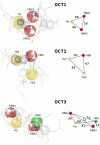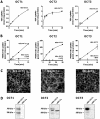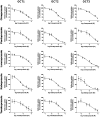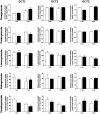Proton pump inhibitors inhibit metformin uptake by organic cation transporters (OCTs)
- PMID: 21779389
- PMCID: PMC3136501
- DOI: 10.1371/journal.pone.0022163
Proton pump inhibitors inhibit metformin uptake by organic cation transporters (OCTs)
Abstract
Metformin, an oral insulin-sensitizing drug, is actively transported into cells by organic cation transporters (OCT) 1, 2, and 3 (encoded by SLC22A1, SLC22A2, or SLC22A3), which are tissue specifically expressed at significant levels in various organs such as liver, muscle, and kidney. Because metformin does not undergo hepatic metabolism, drug-drug interaction by inhibition of OCT transporters may be important. So far, comprehensive data on the interaction of proton pump inhibitors (PPIs) with OCTs are missing although PPIs are frequently used in metformin-treated patients. Using in silico modeling and computational analyses, we derived pharmacophore models indicating that PPIs (i.e. omeprazole, pantoprazole, lansoprazole, rabeprazole, and tenatoprazole) are potent OCT inhibitors. We then established stably transfected cell lines expressing the human uptake transporters OCT1, OCT2, or OCT3 and tested whether these PPIs inhibit OCT-mediated metformin uptake in vitro. All tested PPIs significantly inhibited metformin uptake by OCT1, OCT2, and OCT3 in a concentration-dependent manner. Half-maximal inhibitory concentration values (IC(50)) were in the low micromolar range (3-36 µM) and thereby in the range of IC(50) values of other potent OCT drug inhibitors. Finally, we tested whether the PPIs are also transported by OCTs, but did not identify PPIs as OCT substrates. In conclusion, PPIs are potent inhibitors of the OCT-mediated metformin transport in vitro. Further studies are needed to elucidate the clinical relevance of this drug-drug interaction with potential consequences on metformin disposition and/or efficacy.
Conflict of interest statement
Figures




References
-
- Kirpichnikov D, McFarlane SI, Sowers JR. Metformin: an update. Ann Intern Med. 2002;137:25–33. - PubMed
-
- Boyc KS, Yurgin N, Lage MJ. Trends in the prescription of antidiabetic medications in France: evidence from primary care physicians. Adv Ther. 2007;24:803–813. - PubMed
-
- Filion KB, Joseph L, Boivin JF, Suissa S, Brophy JM. Trends in the prescription of anti-diabetic medications in the United Kingdom: a population-based analysis. Pharmacoepidemiol Drug Saf. 2009;18:973–976. - PubMed
Publication types
MeSH terms
Substances
LinkOut - more resources
Full Text Sources
Other Literature Sources

